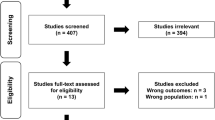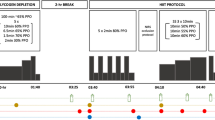Summary
The influence of tapering on the metabolic and performance parameters in endurance cyclists was investigated. Cyclists (n = 25) trained 5 days · week−1, 60 min·day−1, at 75–85% maximal oxygen consumption (VO2max) for 8 weeks and were then randomly assigned to a taper group: 4D (4 days;n = 7), 8D (8 days;n = 6), CON (control, 4 days rest;n = 6), NOTAPER (non-taper, continued training;n = 6). Muscle biopsy specimens taken before and after training and tapering were analysed for carnitine palmityltransferase (CPT), citrate synthase, ß-hydroxyacyl CoA dehydrogenase (HOAD), cytochrome oxidase (CYTOX), lactate dehydrogenase, glycogen and protein. Significant increases inVO2max (6%), a 60-min endurance cycle test (34.5%), oxidative enzymes (77–178%), glycogen (35%) and protein (34%) occurred following training. After the taper, HOAD and CPT decreased 25 % (P<0.05) and 26% respectively, in the CON. Post-taper CYTOX values were different (P<0.05) for 4D and 8D compared with CON. Muscle glycogen levels were increased (P<0.05) after tapering in the 4D, 8D and CON, but decreased in NOTAPER. Similarly, power output at ventilation threshold was significantly increased in the 4D (27.4 W) and 8D (27 W) groups, but decreased (22 W) in the NOTAPER. These findings suggest that tapering elicited a physiological adaptation by altering oxidative enzymes and muscle glycogen levels. Such an adaptation may influence endurance cycling during a laboratory performance test.
Similar content being viewed by others
References
Banister EW, Calvert TW (1980) Planning for future performance: implications for long term training. Can J Appl Sport Sci 5:170–176
Bergmeyer HU (1974) Methods of enzymatic analysis, vol 2. Academic Press, New York
Bergstrom J (1962) Muscle electrolytes in man. Scand J Clin Lab Invest 68:1–110
Bergstrom J, Hermansen L, Hultman E, Saltin B (1967) Diet, muscle glycogen and physical performance. Acta Physiol Scand 71:140–150
Booth FW, Holloszy JO (1977) Cytochrome c turnover in rat skeletal muscles. J Biochem Chem 252:416–419
Chance B, Williams GR (1955) Respiratory enzymes in oxidative phosphorylation: kinetics of oxygen utilization. J Biol Chem 7:383–393
Chi MM, Hintz CS, Coyle EF, Martin WH, Ivy JL, Nemeth PM, Holloszy JO, Lowry OH (1983) Effects of detraining on enzymes of energy metabolism in individual human muscle fibers. Am J Physiol 244: C276-C287
Cohen J (1977) Statistical power analysis for the behavioral sciences. Academic Press, Orlando, Fla.
Coulee RK (1987) Muscle glycogen and exercise endurance: a twenty-year perspective. Exerc Sport Sci Rev 15:1–29
Costill DL (1986) Inside running: basis of sport physiology. Benchmark Press, Indianapolis, pp 123–152
Costill DL, Fink WJ, Getchell LH, Ivy JL, Witzmann FA (1979) Lipid metabolism in skeletal muscle of endurance-trained males and females. J Appl Physiol 47:787–791
Costill DL, King DS, Thomas R, Hargreaves M (1985) Effects of reduced training on muscular power in swimmers. Phys Sports Med 13:94–101
Coyle EF, Martin WH, Sinacore DR, Joyner MJ, Hagberg JM, Holloszy JO (1984) Time course of loss of adaptations after stopping prolonged intense endurance training. J Appl Physiol 47:1857–1864
Davies KJ, Packer L, Brooks GA (1981) Biochemical adaptation of mitochondria, muscle, and whole-animal respiration to endurance training. Arch Biochem Biophys 209:539–554
Dudley GA, Abraham WA, Terjung RJ (1982) Influence of exercise intensity and duration on biochemical adaptations in skeletal muscle. J Appl Physiol 53:844–850
Evans W, Pinney S, Young VR (1982) Suction applied to a muscle biopsy maximizes sample size. Med Sci Sports Exerc 14:101–103
Gollnick PD, Saltin B (1982) Significance of skeletal muscle oxidative enzyme enhancement with endurance training. Clin Physiol 2:1–12
Henriksson J, Reitman JS (1977) Time course of changes in human skeletal muscle succinate dehydrogenase and cytochrome oxidase activities and maximal uptake with physical activity and inactivity. Acta Physiol Scand 99:91–97
Hermansen L, Hultman E, Saltin B (1967) Muscle glycogen during prolonged severe exercise. Acta Physiol Scand 71:129–139
Hickson RC, Rosenkoetter MA (1981) Reduced training frequencies and maintenance of increased aerobic power. Med Sci Sports Exerc 13:13–16
Hinkle DE, Wiersma W, Jurs SG (1979) Applied statistics for the behavioral sciences. Houghton Mifflin, Boston, Mass.
Holloszy JO (1976) Adaptations of muscular tissue to training. Proc Cardiovasc Dis 18:445–458
Holloszy JO, Booth FW (1976) Biochemical adaptations to endurance exercise in muscle. Annu Rev Physiol 38:273–291
Holloszy JO, Coyle EF (1984) Adaptations of skeletal muscle to endurance exercise and their metabolic consequences. J Appl Physiol 56:831–838
Houston ME, Bentzen H, Larsen H (1979) Interrelationships between skeletal muscle adaptations and performance as studied by detraining and retraining. Acta Physiol Scand 105:163–170
Hultman E (1967) Physiological role of muscle glycogen in man, with specific reference to exercise. Circ Res 20-21 [Suppl 1]:199–1114
Hultman E, Bergstrom J, Roch-Norland AE (1971) Glycogen storage in human skeletal muscle. In: Pernow E, Saltin B (eds) Muscle metabolism during exercise. Plenum, New York, pp 273–288
Jones NL, Ehrsam RE (1982) The anaerobic threshold. Exerc Sport Sci Rev 10:49–83
Lowry OH, Rosebrough NL Farr AL, Randall RJ (1951) Protein determination with the Folin phenol treagent. J Biol Chem 193:265–275
Lowry CV, Kimmey JS, Felder S, Chi MM, Kaiser KK, Passonneau PN, Kirk KA, Lowry OH (1978) Enzyme patterns in single human muscle fibers. J Biol Chem 253:8269–8277
McLellan TM, Skinner JS (1985) Submaximal endurance performance related to the ventilation thresholds. Can J Sport Sci 10:81–87
Montpetit RR (1982) Etude de deux programmes d'affutage sur la performance en natation. In: Hogg J, Montpetit RR (eds) Tapering; Coaching the championship swimmer, Level III Technical. Canadian Amateur Swim Association, Ottawa, Ontario Neary JP,
MacDougall JD, Bachus R, Wenger HA (1985) The relationship between the lactate and ventilatory thresholds: coincidental or cause and effect? Eur J Appl Physiol 54:104–108
Neufer PD (1989) The effects of detraining and reduced training on the physiological adaptations of aerobic exercise training. Sports Med 8:302–321
Newsholme EA, Start C (1973) Regulation in metabolism. Wiley, London
Peronnet F, Thibault G, Rhodes EC, McKenzie DC (1987) Correlation between ventilation threshold and endurance capability in marathon runners. Med Sci Sports Exerc 19:610–615
Pyke FS, Craig NP, Norton KI (1988) Physiological and psychological responses of pursuit and sprint track cyclists to a period of reduced training. In: Burke ER, Newsom MM (eds) Medical and scientific aspects of cycling. Human Kinetics, Champaign, Ill
Schantz PG (1986) Plasticity of human skeletal muscle. Acta Physiol Scand [Suppl] 558:6–62
Sharp DS, Gahlinger PM (1988) Regression analysis in biological research: sample size and statistical power. Med Sci Sports Exerc 20:605–610
Soussi B, Idstrom JP, Schersten T, Byland-Fellenius AC (1989) Kinetic parameters of cytochrome c oxidase in rat skeletal muscle: effect of endurance training. Acta Physiol Scand 135:373–379
Suarez RK, Brown GS, Hochachka PW (1986) Metabolic sources of energy for hummingbird flight. Am J Physiol 251:R537-R542
Thoden JS (1991) Testing aerobic power. In: MacDougall JD, Wenger HA, Green HJ (eds) Physiological testing of the highperformance athlete. Human Kinetics, Champaign, Ill
Author information
Authors and Affiliations
Rights and permissions
About this article
Cite this article
Neary, J.P., Martin, T.P., Reid, D.C. et al. The effects of a reduced exercise duration taper programme on performance and muscle enzymes of endurance cyclists. Europ. J. Appl. Physiol. 65, 30–36 (1992). https://doi.org/10.1007/BF01466271
Accepted:
Issue Date:
DOI: https://doi.org/10.1007/BF01466271




